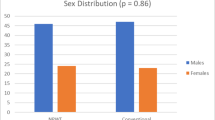Abstract
Purpose
The purpose of this study was to evaluate the use of negative pressure wound therapy (NPWT) to improve wound healing after total hip arthroplasty (THA) and its influence on the development of postoperative seromas in the wound area.
Materials
The study is a prospective randomised evaluation of NPWT in patients with large surgical wounds after THA, randomising patients to either a standard dressing (group A) or a NPWT (group B) over the wound area. The wound area was examined with ultrasound to measure the postoperative seromas in both groups on the fifth and tenth postoperative days.
Results
There were 19 patients randomised in this study. Ten days after surgery, group A (ten patients, 70.5 ± 11.01 years of age) developed seromas with an average size of 5.08 ml and group B (nine patients, 66.22 ± 17.83 years of age) 1.97 ml. The difference was significant (p = 0.021).
Conclusion
NPWT has been used on many different types of traumatic and non traumatic wounds. This prospective, randomised study has demonstrated decreased development of postoperative seromas in the wound and improved wound healing.


Similar content being viewed by others
References
Kanakaris NK, Thanasas C, Keramaris N, Kontakis G, Granick MS, Giannoudis PV (2007) The efficacy of negative pressure wound therapy in the management of lower extremity trauma: review of clinical evidence. Injury 38(Suppl 5):S9–S18. doi:10.1016/j.injury.2007.10.029
Runkel N, Krug E, Berg L, Lee C, Hudson D, Birke-Sorensen H, Depoorter M, Dunn R, Jeffery S, Duteille F, Bruhin A, Caravaggi C, Chariker M, Dowsett C, Ferreira F, Martinez JM, Grudzien G, Ichioka S, Ingemansson R, Malmsjo M, Rome P, Vig S, Martin R, Smith J (2011) Evidence-based recommendations for the use of negative pressure wound therapy in traumatic wounds and reconstructive surgery: steps towards an international consensus. Injury 42 Suppl 1:S1–12. doi:10.1016/S0020-1383(11)00041-6
Lehner B, Fleischmann W, Becker R, Jukema GN (2011) First experiences with negative pressure wound therapy and instillation in the treatment of infected orthopaedic implants: a clinical observational study. Int Orthop. doi:10.1007/s00264-011-1274-y
Stannard JP, Singanamala N, Volgas DA (2010) Fix and flap in the era of vacuum suction devices: what do we know in terms of evidence based medicine? Injury 41(8):780–786. doi:10.1016/j.injury.2009.08.011
Stannard JP, Robinson JT, Anderson ER, McGwin G Jr, Volgas DA, Alonso JE (2006) Negative pressure wound therapy to treat hematomas and surgical incisions following high-energy trauma. J Trauma 60(6):1301–1306. doi:10.1097/01.ta.0000195996.73186.2e
DeCarbo WT, Hyer CF (2010) Negative-pressure wound therapy applied to high-risk surgical incisions. J Foot Ankle Surg 49 (3):299–300. doi:10.1053/j.jfas.2010.01.002
DeFranzo AJ, Argenta LC, Marks MW, Molnar JA, David LR, Webb LX, Ward WG, Teasdall RG (2001) The use of vacuum-assisted closure therapy for the treatment of lower-extremity wounds with exposed bone. Plast Reconstr Surg 108(5):1184–1191
Fleischmann W, Russ M, Marquardt C (1996) Closure of defect wounds by combined vacuum sealing with instrumental skin expansion. Unfallchirurg 99(12):970–974
Horch RE, Münchow S, Dragu A (2011) Erste Zwischenergebnisse der Perfusionsbeeinflussung durch Prevena: Gewebsperfusion. Z Wundheilung A 16:19–20
Dedmond BT, Kortesis B, Punger K, Simpson J, Argenta J, Kulp B, Morykwas M, Webb LX (2007) The use of negative-pressure wound therapy (NPWT) in the temporary treatment of soft-tissue injuries associated with high-energy open tibial shaft fractures. J Orthop Trauma 21(1):11–17. doi:10.1097/BOT.0b013e31802cbc54
Lehner B, Bernd L (2006) V.A.C.-instill therapy in periprosthetic infection of hip and knee arthroplasty. Zentralbl Chir 131(Suppl 1):S160–S164. doi:10.1055/s-2006-921513
Brem MH, Blanke M, Olk A, Schmidt J, Mueller O, Hennig FF, Gusinde J (2008) The vacuum-assisted closure (V.A.C.) and instillation dressing: limb salvage after 3 degrees open fracture with massive bone and soft tissue defect and superinfection. Unfallchirurg 111(2):122–125. doi:10.1007/s00113-007-1360-1
Gesslein M, Horch RE (2006) Interdisciplinary management of complex chronic ulcers using vacuum assisted closure therapy and "buried chip skin grafts". Zentralbl Chir 131(Suppl 1):S170–S173. doi:10.1055/s-2006-921460
Loos B, Kopp J, Kneser U, Weyand M, Horch RE (2006) The importance of vacuum therapy in the treatment of sternal osteomyelitis from the plastic surgeons point of view. Zentralbl Chir 131(Suppl 1):S124–S128. doi:10.1055/s-2006-921425
Stannard JP, Volgas DA, Stewart R, McGwin G Jr, Alonso JE (2009) Negative pressure wound therapy after severe open fractures: a prospective randomized study. J Orthop Trauma 23(8):552–557. doi:10.1097/BOT.0b013e3181a2e2b6
Fleischmann W, Strecker W, Bombelli M, Kinzl L (1993) Vacuum sealing as treatment of soft tissue damage in open fractures. Unfallchirurg 96(9):488–492
Horch RE, Gerngross H, Lang W, Mauckner P, Nord D, Peter RU, Vogt PM, Wetzel-Roth W, Willy C (2005) Indications and safety aspects of vacuum-assisted wound closure. MMW Fortschr Med 147(Suppl 1):1–5
Willy C, von Thun-Hohenstein H, von Lubken F, Weymouth M, Kossmann T, Engelhardt M (2006) Experimental principles of the V.A.C.-therapy—pressure values in superficial soft tissue and the applied foam. Zentralbl Chir 131(Suppl 1):S50–S61. doi:10.1055/s-2006-921421
Stannard JP, Atkins BZ, O'Malley D, Singh H, Bernstein B, Fahey M, Masden D, Attinger CE (2009) Use of negative pressure therapy on closed surgical incisions: a case series. Ostomy Wound Manage 55(8):58–66
Kaplan M, Daly D, Stemkowski S (2009) Early intervention of negative pressure wound therapy using vacuum-assisted closure in trauma patients: impact on hospital length of stay and cost. Adv Skin Wound Care 22(3):128–132. doi:10.1097/01.ASW.0000305451.71811.d5
Acknowledgments
Matthias H. Brem gave scientific presentations for KCI. The PREVENATM wound treatment system was provided by KCI free of charge.
Author information
Authors and Affiliations
Corresponding author
Additional information
Milena Pachowsky and Johannes Gusinde both contributed equally to this manuscript.
Rights and permissions
About this article
Cite this article
Pachowsky, M., Gusinde, J., Klein, A. et al. Negative pressure wound therapy to prevent seromas and treat surgical incisions after total hip arthroplasty. International Orthopaedics (SICOT) 36, 719–722 (2012). https://doi.org/10.1007/s00264-011-1321-8
Received:
Accepted:
Published:
Issue Date:
DOI: https://doi.org/10.1007/s00264-011-1321-8




